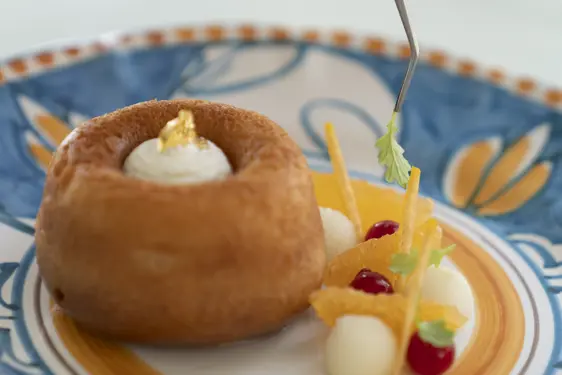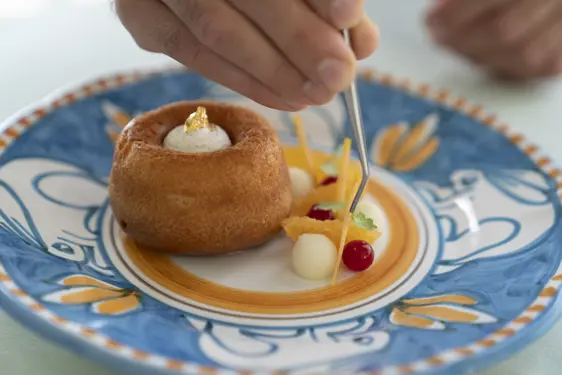BRING ON THE BABÀ
04.08.2022 RECIPES
Not least because eating it can be a challenge. Try and nibble genteelly on a babà while walking down the street and you’ll end up a sticky mess. In its most classic form, this tempting tidbit is a small sponge-cake shaped rather like a truncated ice-cream cone or a well-behaved mushroom. So far so manageable. But it’s not a babà until it’s been doused in a rum-infused sugar syrup that oozes from every delicious spongey pore as you bite into it. That syrup is the babà’s raison d’être. If you’re a babà beginner, it’s not easy to keep it off fingers, clothes and shoes. Our advice is to consume your babà sitting down, with a fork, in four to five decisive swoops. If in doubt, watch a Neapolitan.
But the babà is serious for another reason too: because it says so much about the history and culture of this cosmopolitan city. Like all the best sweet superheroes, this spongy rum cake has an origin story – all to do with a Polish king, Stanislaus I, who, with time on his hands during a period of exile in the tiny Euro-state of Palatine Zweibrücken in the early 18thcentury, discovered that the rather dry local Alsatian sponge cake, Gugelhupf, could be rendered more palatable by being soaked in the fortified wine known as Madeira. He named the exotic result after Ali Baba, the resourceful hero of one of the most famous tales from the Arabian Nights collection, which had only recently appeared in French translation.

View
Stanislaus’ daughter Marie ended up marrying Louis XV and would become the longest serving queen in French history. It was she, apparently, who introduced sponge cakes soaked in alcohol to the French court, though the spirit of choice soon became the newly fashionable Jamaican rum – an innovation Stanislaus complained about bitterly to his friend Voltaire.
Dynastic connections between the French and Bourbon courts, and the Neapolitan admiration for Parisian cuisine in the 19th century would bring the babà to Naples… and the rest is history. All that remains is to point out that, as served in the city’s pasticcerias and restaurants today, the babà comes in two forms. One is the classic version consisting of a small sponge doused in rum-laced sugar syrup. The other is the more elaborate ‘babà savarin’, consisting of a donut-shaped babà whose central ring is filled with Chantilly cream. This is the supreme indulgence we present in the following recipe, generously offered for babà fans everywhere by Le Sirenuse’s pastry chef Francesco Cozzolino.
Note that the babà savarin you see in the photos is the single-serving version that Francesco makes for guests of La Sponda. We asked him to give us a recipe for a family-sized babà that can be served in slices, but if you do want to try your hand at the individual version – and have been lucky enough to track down a bunch of mini savarin moulds (or cake tins) – simply divide the dough, syrup and cream between the smaller moulds: the quantities below should make around six.

View
BABA’ SAVARIN
Serves one to ten, depending on who gets there first
Sponge mix
70g (2.5oz) sugar
20g (0.7oz) fresh yeast
140g (5oz) butter
400g (14oz) white bread flour
6 eggs
a pinch of salt
Rum syrup
350g (12.3oz) sugar
175ml (6fl.oz) rum
1l (34fl.oz) water
the zest of 4 oranges
vanilla to taste
Chantilly cream
350ml (12fl.oz) chilled heavy whipping cream
40g (1.4oz) sugar
vanilla to taste
Apricot jam for glazing
You will need one important piece of equipment before you start: a savarin mould (it looks like a cake tin for a large half donut, which is basically what a savarin is). A 26cm (10 inch) mould should be about right.
First, make the sponge dough. The easiest way to do this is using a food mixer fitted with a dough hook attachment. Begin as you would if you were making pizza, with the ‘biga’. This is the liquid yeasty starter. Make it by dissolving the yeast in 70g (2.5fl.oz) of lukewarm water. Mix well and leave to rise for an hour or so, covered in clingfilm or a damp cloth.
When the ‘biga’ is ready, put it in the mixer bowl, add the rest of the flour, half of the beaten eggs, the orange zest, the vanilla and the pinch of salt, and work until even. With the dough hook still turning, incorporate a little of the soft (but not melted) butter followed by a little of the sugar, alternating until it’s all been absorbed. Finally, add the rest of the beaten eggs, a little at a time, and continue stirring for at least ten minutes until you have a smooth, springy dough mix.
At this point. spoon the dough into the buttered savarin mould and leave it to rise in a warm place for another hour or so. While it’s rising, set your oven to 180°C (356°F). When the savarin has more or less doubled in size, place it in the oven and bake for an hour until golden. Set aside to cool.
Compared to the savarin, the other two stages are relatively easy. To make the rum syrup, put the water, sugar and orange zest in a tall saucepan, bring to the boil and stir until all the sugar is dissolved. At this point, take the pan off the heat and add the rum (that way, it won’t all evaporate). Cover and leave to infuse and cool down.
The chantilly cream is a cinch. Simply beat the cream, sugar and vanilla extract together until soft peaks form. That’s it.
Finally, take some apricot jam (half a jar should do), sieve or blitz it to remove any lumps, and add some of the rum syrup to dilute it a little. You will use this to glaze the savarin.
Now comes the fun part. Put the rest of the rum syrup in a jug that you are confident pours well and accurately. With the savarin still in its mould, pour the syrup onto the sponge, all around, and wait until it has been absorbed. Next, take the savarin carefully out of the mould and place it upside down on a wire rack under which you have placed a tray to catch the syrup. Now, pour more of the syrup on the underside of the cake. Keep going, turning the savarin if necessary, until all the syrup has been absorbed. You don’t want to skimp on this: a good babà should be absolutely soaking in syrup.
Brush the apricot glaze all over the surface of the savarin. Finally, put the chantilly cream in a piping bag, and pipe it artistically into the centre of the cake.
You will notice from the photos that Francesco like to garnish his mini-babà with fresh and dried citrus fruits and preserved cherries. But you can choose any garnish that takes your fancy. In Neapolitan pasticcerias, strawberries, raspberries and redcurrants are all popular.
And there you have it. Si ‘nu bbabbà a rrumma, as an old-school Neapolitan might say to an attractive woman: you are as delicious as a rum babà.
Photos © Roberto Salomone
Le Sirenuse Newsletter
Stay up to date
Sign up to our newsletter for regular updates on Amalfi Coast stories, events, recipes and glorious sunsets



